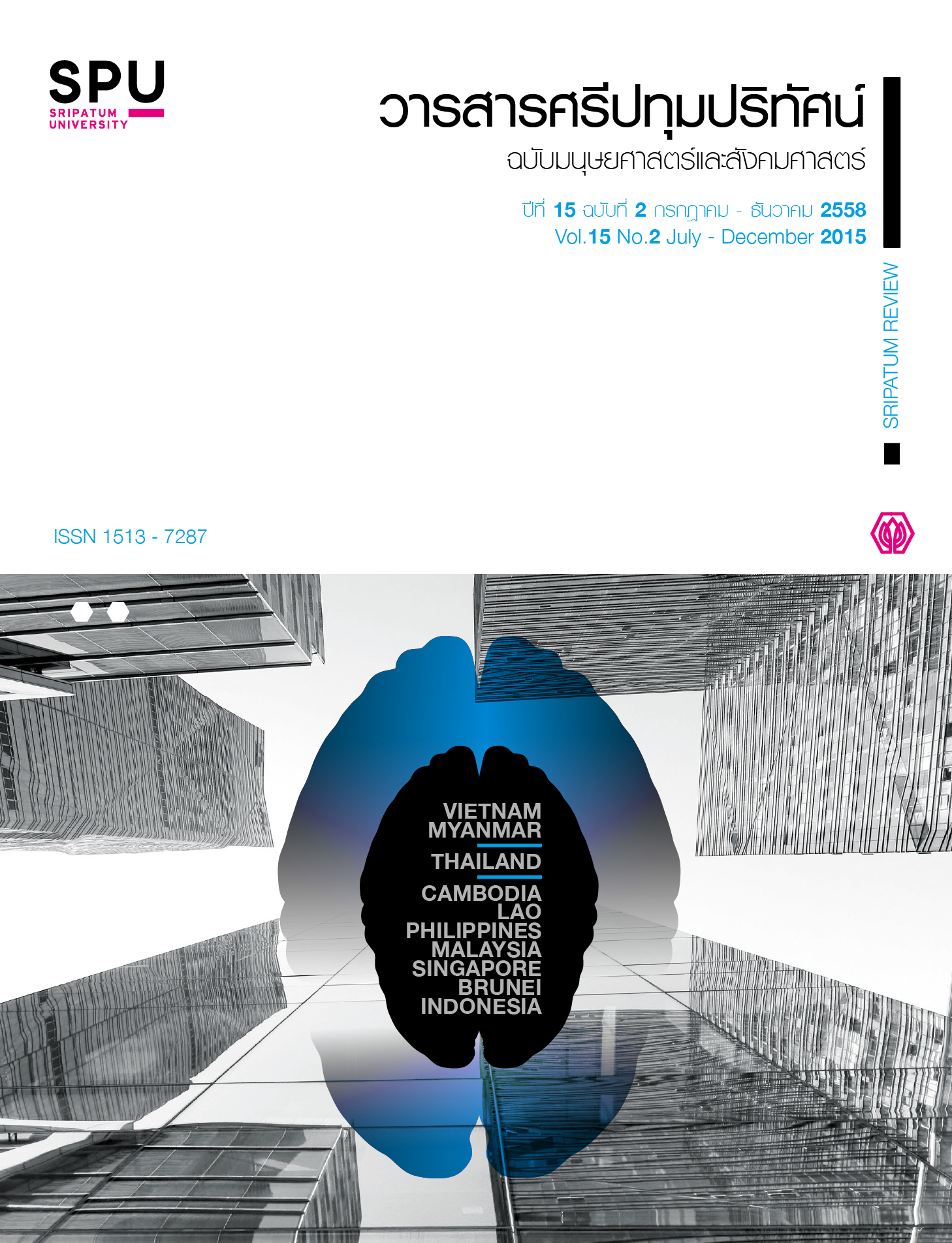MODEL OF FLIPPED CLASSROOM LEARNING ENVIRONMENT FOR MUSIC LESSONS
Main Article Content
Abstract
This article deals with the main part of a research study on development of a model of flipped-classroom learning environment for music lessons using three media formats, namely, the video clips, the augmented reality, and the Facebook social media for secondary school students. The research sample for this study consisted of three experts in educational technology for evaluation of the model appropriateness, and 90 Mathayom Suksa 5 students obtained by multi-stage sampling for the study of their satisfaction with the flipped classroom learning environment for music lessons. Statistics for data analysis were the percentage, mean, and standard deviation.
Research findings showed that (1) the experts had overall opinion that the model of flipped classroom learning environment for music lessons was appropriate at the highest level; and (2) the students were satisfied with the flipped-classroom music learning environment at the high level.
Article Details
1. กองบรรณาธิการสงวนสิทธิ์ในการพิจารณาและตัดสินการตีพิมพ์บทความในวารสาร
2. บทความทุกเรื่องจะได้รับการตรวจสอบทางวิชาการโดยผู้ทรงคุณวุฒิ แต่ข้อความและเนื้อหาในบทความที่ตีพิมพ์เป็นความรับผิดชอบของผู้เขียนแต่เพียงผู้เดียว มิใช่ความคิดเห็นและความรับผิดชอบของมหาวิทยาลัยศรีปทุม
3. การคัดลอกอ้างอิงต้องดำเนินการตามการปฏิบัติในหมู่นักวิชาการโดยทั่วไป และสอดคล้องกับกฎหมายที่เกี่ยวข้อง
References
ทิศนา แขมมณี. 2556. ศาสตร์การสอน: องค์ความรู้เพื่อการจัดกระบวนการเรียนรู้ที่มีประสิทธิภาพ. พิมพ์ครั้งที่ 17 กรุงเทพฯ: ด่านสุทธาการพิมพ์.
นุชลี อุปภัย. 2555. จิตวิทยาการศึกษา. กรุงเทพฯ: จุฬาลงกรณ์มหาวิทยาลัย.
วัฒนาพร ระงับทุกข์. 2545. เทคนิคและกิจกรรมการเรียนรู้ที่เน้นผู้เรียนเป็นสําคัญตามหลักสูตรการศึกษาขั้นพื้นฐาน พ.ศ.2544. กรุงเทพฯ: พริกหวานกราฟฟิค.
วิจารณ์ พานิช. 2556. ครูเพื่อศิษย์สร้างห้องเรียนกลับทาง. กรุงเทพฯ: เอสอาร์พริ้นติ้งแมสโปรดักส์.
ศิริรัตน์ เพ็ชร์แสงศรี. 2554. “การเรียนแบบผสมผสาน และการประยุกต์ใช้ (Blended Learning and Its Applications).” วารสารครุศาสตร์อุตสาหกรรม. ฉบับที่ 11: 1-5.
สมจิต จันทร์ฉาย. 2557. การออกแบบและพัฒนาการเรียนการสอน. คณะครุศาสตร์ มหาวิทยาลัยราชภัฏนครปฐม: เพชรเกษมพริ้นติ้งกรุ๊ป.
สุมาลี ชัยเจริญ. 2551. เทคโนโลยีการศึกษา: หลักการ ทฤษฎีสู่การปฏิบัติ. ขอนแก่น: คลังนานาวิทยา.
สุรางค์ โค้วตระกูล. 2556. จิตวิทยาการศึกษา. กรุงเทพฯ: จุฬาลงกรณ์มหาวิทยาลัย.
อนุศร หงษ์ขุนทด. 2558. “การพัฒนารูปแบบระบบการเรียนแบบห้องเรียนกลับด้านผ่านสื่อ3 แบบ ด้านทักษะดนตรี สำหรับนักเรียนชั้นมัธยมศึกษา”. วิทยานิพนธ์ปริญญาดุษฎี บัณฑิต สาขาเทคโนโลยีและสื่อสารการศึกษา บัณฑิตวิทยาลัย มหาวิทยาลัยเกษตรศาสตร์.
Baker, J.W. 2000. The “Classroom Flip”. Using Web Course Management Tools to Become the Guide on the Side, In11th international conference on college teaching and learning, Jacksonville, FL.
Bednar, A.K., Cunningham, D., Duffy, T. M., and Perry, J. D., 1991. Theory into Practice: How Do We Link? In G. J. Anglin (Ed). (2nd ed., 100-12).Englewood, CO: Libraries Unlimited.
Bergmann, J. and A. Sams and A. Sams. 2012.“Flipping the Classroom.” Tech and Learning. 32(10): 42-43.
Bonwell, C.C. and J.A. Eison. 1991. Active Learning: Creating Excitement in the Classroom. 1991 Ashe-Eric Higher Education Reports. ERIC.
Carman, J.M. 2005. Blended Learning Design: Five Key Ingredients.
DeWitte, C.M. 2010. Integrating Cell Phones into the Secondary Montessori Classroom. 3397339, Walden University.
Duffy, T.M. and D.J. Cunningham. 1996. Constructivism: Implications for the Design and Delivery of Insturctionp. 170-198. in D. Jonassen, Eds. Handbook of Research for Educational Communications and Technology. Simon and Schuster Macmillan, New York.
Gerstein, J. 2011. The Flipped Classroom Model: A Full Picture.
Guoqing Zhou, z.n.e.c. and J. Xuefeng. 2014. “Theoretical Research and Instructional Design of the Flipped Classroom.” Applied Mechanics & Materials.
543-547(4312-4315).
Khan, B.H. 2005. Managing E-Learning: Design, Delivery, Implementation, and Evaluation. Information Science Publishing.
Norberg, A., C.D. Dziuban and P.D. Moskal. 2011. “A Time‐Based Blended Learning Model.”On the Horizon. 19(3): 207-216.
Siemens, G. 2004. Connectivism: A Learning Theory for the Digital Age.
Spencer, D. 2012. "Flipping" Educational Technology Professional Development for K-12 Educators. 1518062, Michigan State University.
Staker, H. 2011. The Rise of K–12 Blended Learning Profiles of Emerging Models. Innosight Institute, Inc.
Strayer, J.F. 2007. The Effects of the Classroom Flip on the Learning Environment: A Comparison of Learning Activity in a Traditional Classroom and a Flip Classroom That Used an Intelligent Tutoring System. 3279789, the Ohio State University.


